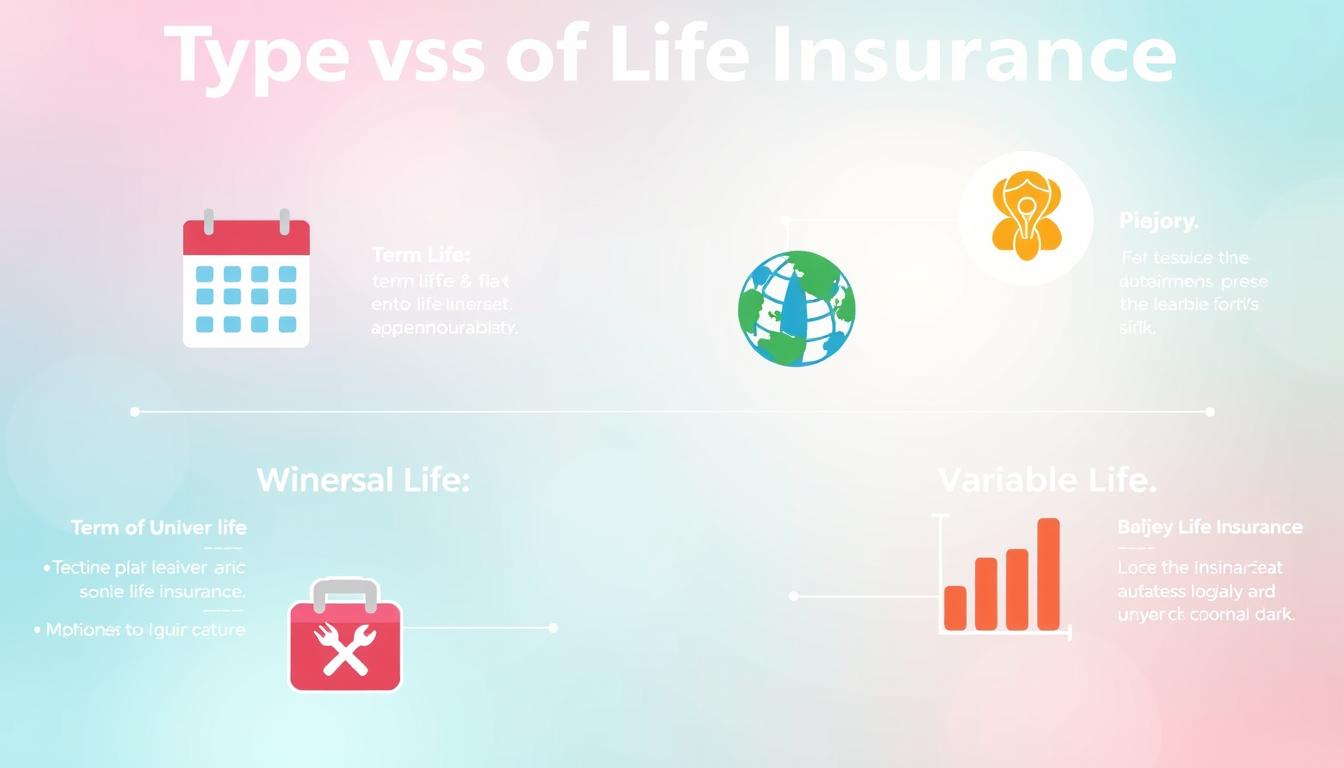Did you know the average American household has less than $5,000 in life insurance? This fact shows how crucial it is to know about the different life insurance options. From basic term life to special final expense policies, the choices can be confusing. But, with the right info, you can pick the best coverage for your family.
This guide will cover the many types of life insurance. We’ll look at their unique features, benefits, and things to consider. Whether you’re a young professional or a retiree, knowing about life insurance can help you make a smart choice for your needs.
Key Takeaways
- Life insurance is a key financial tool that protects your loved ones if you pass away too soon.
- There are many types of life insurance, each with its own pros and cons, like term, whole, universal, and variable life.
- Special policies like final expense and group life offer extra coverage for specific needs.
- It’s important to research and understand life insurance types to find the right one for your situation.
- Talking to a financial advisor can help you understand life insurance better and make sure you have enough coverage.
Understanding the Essence of Life Insurance
Life insurance is a key financial tool that gives protection and security to individuals and their families. It’s more than a policy; it shows the value of planning for the future. It ensures your family is cared for, no matter what happens.
Why Life Insurance Matters
The importance of life insurance is huge. It provides many benefits that give peace of mind and financial stability. These benefits include:
- Income Replacement: Life insurance can replace lost income, keeping your family’s standard of living if you’re not there to support them.
- Debt Coverage: It can pay off debts like a mortgage or loans, so your family isn’t burdened with these financial issues.
- Legacy Planning: Life insurance can be used to leave a financial gift for your children or charity, creating a lasting legacy.
Key Factors to Consider
When buying life insurance, consider these important factors to pick the right policy features and coverage needs:
- Coverage Amount: Figure out how much coverage you need based on your family’s financial duties and lifestyle.
- Policy Duration: Pick a policy term that fits your long-term financial goals and protection needs.
- Premium Costs: Look at the cost of premiums and balance it with the level of life insurance protection you need.
- Policy Features: Know the specific features of the policy, including any exclusions or limitations, to make sure it meets your coverage needs.
By thinking about these key factors, you can make a smart choice. This ensures your life insurance policy gives your family the financial security and protection they deserve.
A Comprehensive Guide to Types of Life Insurance
Life insurance is key to protecting your loved ones’ financial future. It can be hard to pick the right type, but knowing the options helps. Let’s look at the main types of life insurance in the U.S.
Term Life Insurance: This policy covers you for a set time, called the “term.” It’s usually the cheapest option. Many people choose it for temporary coverage or when they’re watching their budget.
Whole Life Insurance: This type covers you for life. It has a death benefit and a cash value that grows. This makes it a solid financial safety net.
Universal Life Insurance: This policy lets you change your premiums and death benefit as your life changes. It combines term and whole life insurance benefits. This means you get protection and a chance for cash value growth.
Variable Life Insurance: This policy ties your death benefit and cash value to investments. It could offer higher returns but also more risk.
- Final Expense Insurance: This policy covers costs at the end of life, like funerals. It has a smaller death benefit and is mainly for seniors.
- Group Life Insurance: Your employer or group offers this at a lower cost. It’s easy for many to get.
- Survivorship Life Insurance: Known as “second-to-die” insurance, it covers two people and pays out after the second person dies. It’s good for estate planning.
Knowing about these life insurance types helps you pick the right one for your goals and needs. Talk to an insurance expert to find the best one for you.

Conclusion
This article has looked into the wide world of life insurance. It shows why it’s key to know about the different types of coverage. These options help protect individuals and families financially.
It covered term life, whole life, and universal life insurance. Each type has its own set of features and benefits. This helps readers pick the right policy for their needs.
The article stressed how life insurance is crucial for protecting your family’s financial future. It covers expenses and ensures a stable future. It’s important to think about your age, income, dependents, and financial goals when choosing coverage.
When looking into life insurance, it’s important to explore your options carefully. Picking the right policy can greatly improve your financial security and your family’s well-being. By understanding life insurance well, you can make choices that give you and your family peace of mind.
FAQ
What is the difference between term life insurance and whole life insurance?
Term life insurance covers you for a set time. Whole life insurance covers you for life. Term life is cheaper but pays out only if you die during the term. Whole life costs more but grows cash value and covers you for life.
What is universal life insurance, and how does it work?
Universal life insurance is a flexible type of permanent insurance. You can change your premiums and coverage as your needs change. It has a death benefit and a savings part. The cash value grows tax-free and can be used for loans or withdrawals.
What is variable life insurance, and how does it differ from other types?
Variable life insurance lets you invest the cash value in different funds, like mutual funds. The death benefit and cash value can change with the investment performance. This means you could get higher returns but also face more risk than other types of life insurance.
What is final expense insurance, and who is it designed for?
Final expense insurance helps cover costs like funerals and medical bills at the end of life. It’s a whole life policy with a smaller death benefit, usually ,000 to ,000. It’s for older adults who want to make sure their loved ones aren’t left with these costs.
What is group life insurance, and how does it differ from individual life insurance?
Group life insurance is offered through a job, group, or organization. It’s cheaper because it spreads the risk among many people. But, it’s not as flexible as individual insurance and may not follow you if you leave the group.
What is survivorship life insurance, and who can benefit from it?
Survivorship life insurance covers two people and pays out after the second person dies. It’s used for estate planning to cover taxes and help dependents or heirs after the first person passes away.
READ MORE:
